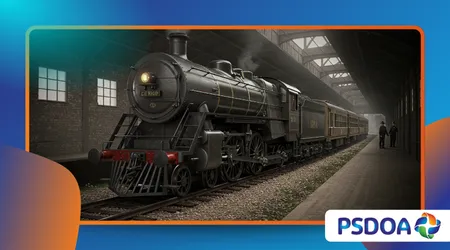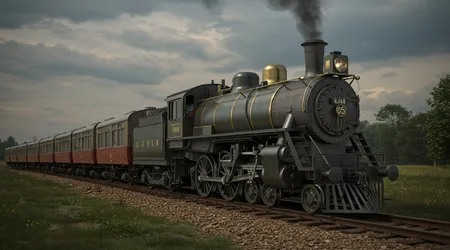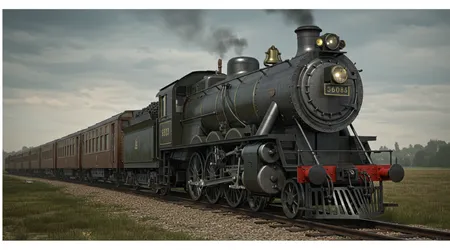How Vacuum Trains Were Almost a Reality in the 1800s

Trains Were Almost a Reality in the 1800s in an era defined by steam, iron, and revolutionary invention, engineers pursued concepts that seem ripped from modern science fiction.
Anúncios
One of the most audacious, yet nearly realized, visions of the Victorian age was the atmospheric railway. This incredible system, where vacuum Trains Were Almost a Reality in the 1800s, promised a silent, efficient, and breathtakingly fast mode of transport, completely bypassing the limitations of the traditional steam locomotive.
It’s a forgotten chapter of engineering history, a tantalizing “what if” that demonstrates the sheer ambition of 19th-century innovators.
We must look closely at this remarkable technology, understand its brief success, and analyze the fatal flaws that ultimately doomed it to the archives of abandoned brilliance.
The story reveals deep lessons about the nature of technological competition and the harsh realities of scaling up ambition.
Anúncios
The Ingenious Mechanics: Power Without Steam
The atmospheric railway concept was driven by a clear goal: eliminate the costly, cumbersome, and smoke-belching steam engine. It sought a cleaner, more reliable kinetic energy source.
The Concept: A Giant Pneumatic Tube
Imagine the entire railway line as a massive, continuous pneumatic tube. That’s essentially the core principle of the atmospheric system. A large iron pipe, running between the rails, was the heart of the propulsion system.
This pipe contained a piston attached to the underside of the train carriage. Fixed pumping stations, built alongside the track every few miles, would evacuate the air from the pipe ahead of the piston.
The resulting pressure differential the vacuum ahead and the atmospheric pressure pushing from behind provided the clean, powerful force to move the train. This elegant mechanism promised smooth, rapid acceleration unlike anything powered by coal and water.
++ Roman Concrete: How Ancient Builders Created Structures That Lasted Millennia
The Great Innovation: The Continuous Valve
The critical challenge lay in how to maintain the vacuum while allowing the piston rod to connect the carriage to the pipe. This required a continuous seal that could be momentarily opened and immediately closed.
The patented solution, championed by the English engineers Samuel Clegg and Joseph Samuda, was revolutionary. They devised a longitudinal valve a leather flap running the entire length of the pipe sealed with a mixture of grease and wax.
As the piston passed, it lifted the flap ahead, allowing the piston rod through, and a following wheel immediately pressed the flap back down, while a heated iron plate sealed the wax again.
Also read: Forgotten Monorail Designs That Were Way Ahead of Their Time
This continuous, flexible seal was the engineering marvel that truly made atmospheric Trains Were Almost a Reality in the 1800s.
The simplicity of the propulsion using the abundant power of atmospheric pressure contrasted starkly with the complexity of the required sealing technology. The initial tests demonstrated fantastic speed, thrilling contemporary observers with the smooth, rapid progress.

The Brief Reign: Practical Implementations
This groundbreaking technology was not merely a theoretical drawing board concept; it was actively deployed and tested on commercial routes, demonstrating its viability and potential.
The Dublin & Kingstown Railway Experiment
The first significant test came in 1843 on a segment of the Dublin & Kingstown Railway in Dalkey, Ireland. This short, steep section was ideal for the technology, as the stationary pumping engines handled the inclines far more efficiently than steam locomotives could.
The results were astonishing: the trains achieved speeds up to 48 miles per hour competitive with the fastest steam trains of the era but did so quietly and without any smoke or dirt. The passengers were reportedly delighted by the clean, smooth journey.
Read more: The Mechanical TV: How Moving Discs Almost Became the Norm
The Croydon Disaster and the South Devon Scheme
Inspired by the Irish success, the ambitious South Devon Railway, under the chief engineering guidance of Isambard Kingdom Brunel, adopted the atmospheric system for an extensive mainline. Brunel, one of history’s greatest engineers, believed this was the future.
This South Devon line, opened in 1847, was the atmospheric railway’s high-water mark. However, its expansive scale soon revealed the system’s insurmountable Achilles’ heel: the perishable nature of the leather seal.
The continuous flap, exposed to the elements, quickly deteriorated. Rats and other vermin found the wax and grease mixture a delicious meal, leading to catastrophic leaks. Brunel’s grand vision of vacuum Trains Were Almost a Reality in the 1800s began to suffer constant delays and crippling maintenance costs.
The ambitious scope of the project, covering over 20 miles, meant that a small leak in one section could cripple the entire line, demanding constant, expensive, and often futile maintenance. The dream of a clean, fast future was literally being eaten by rodents and dissolved by rain.
The Fatal Flaws: Why the Steam Engine Won

Despite its elegant mechanical principle, the atmospheric railway failed to compete with the sheer brute force and decentralized flexibility of the steam locomotive. The steam engine, while messy, was robust and self-contained.
Scalability and Maintenance Nightmares
The steam engine carried its power source with it, offering complete operational independence. The atmospheric system, conversely, required an expensive, complex network of fixed, powerful pumping stations every two or three miles along the entire route.
The critical flaw was system fragility. If one pumping station failed, or if the valve sprung a leak at any point, the entire section was immobilized. This lack of resilience made the timetable unreliable, a deathblow for any public transport system.
Analogia: The atmospheric system was akin to a single chain of holiday lights; if one bulb (or pump) failed, the whole line went dark. The steam locomotive was a series of independent candles; if one went out, the others kept burning. This inherent frailty is why vacuum Trains Were Almost a Reality in the 1800s ultimately failed.
The Economic Reality of Materials
The constant need to repair and replace the specialized leather and wax seals proved financially ruinous. The cost of labor and materials to maintain a continuous, perfect vacuum seal over hundreds of miles was astronomical, easily eclipsing the fuel savings from not using coal in the locomotives.
In 1848, the directors of the South Devon Railway conducted a brutally honest analysis. They found that the operational costs were simply unsustainable.
They chose to scrap the entire atmospheric infrastructure pipes, pumps, and all and revert to traditional steam power. This decision, though disappointing, proved the steam locomotive was the superior economic technology for that era.
The Legacy: A Premature Genius
The failure of the atmospheric railway was not a failure of physics, but a failure of materials science and economic feasibility in the mid-19th century. Its core principles, however, have enjoyed a fascinating resurgence.
The Modern Echoes: Pneumatic Transport
The fundamental idea of using a pressure differential for transport is alive and well today. We see it in sophisticated form in modern pneumatic tube systems used in banks, hospitals, and large offices.
Even the concept of the Hyperloop, championed by modern entrepreneurs, is a high-speed, advanced iteration of the atmospheric principle, utilizing a near-vacuum environment to eliminate air resistance.
The atmospheric railway was simply a century ahead of its time. The materials science needed for a durable, non-perishable, continuous seal (like modern polymers and composite materials) did not exist. The decentralized electric motor, which could replace large, centralized pumping stations, was still decades away from maturity.
| Railway System Feature | Atmospheric Railway (c. 1845) | Steam Locomotive (c. 1845) |
| Propulsion Source | External Fixed Pumping Stations | Onboard Boiler/Engine |
| Operational Cleanliness | Very Clean (No Smoke/Cinders) | Very Dirty (Smoke/Cinders/Noise) |
| Maintenance Burden | High (Due to Seal Failure/Vermin) | Medium (Boiler/Engine Repair) |
| System Fragility | High (One leak stops the entire line) | Low (Self-contained units) |
A Lesson in Technological Timing
The atmospheric railway serves as a potent reminder that technological success depends on more than just genius; it requires the surrounding ecosystem materials, cost, and maintenance infrastructure to be ready.
The engineers who believed vacuum Trains Were Almost a Reality in the 1800s had the correct vision for high-speed, clean transport. They simply lacked the Teflon, advanced rubber, and cheap, reliable electricity needed to make it commercially viable.
Their bold, yet ultimately doomed, venture provided invaluable practical experience. It demonstrated the limits of continuous mechanical seals over vast distances, information that directly informed later tunnel and plumbing projects. This chapter of forgotten innovation deserves our respect.
Conclusion: The Endurance of the Idea
The story of how vacuum Trains Were Almost a Reality in the 1800s is more than a historical footnote; it is a profound lesson in the trajectory of innovation.
It shows us that many of the “new” ideas exciting us today from Hyperloop to modular transport systems have deep historical roots. The failure of the atmospheric system was a technical and economic defeat, but the idea itself was a victory of imagination.
It proved that human ingenuity, when pressed by the demands of speed and efficiency, will always seek to harness the fundamental powers of physics.
Next time you hear about a futuristic transport concept promising speeds beyond the conventional rail, remember those ambitious Victorian engineers on the South Devon line, battling rats and leaky seals. They paved the way.
What forgotten historical concept do you think deserves a modern second chance? Share your thoughts and forgotten inventions in the comments below!
Frequently Asked Questions
Q: Why did they not use metal seals instead of leather and wax?
The main challenge was flexibility. The seal had to open momentarily to allow the piston connecting rod through, then immediately close perfectly to maintain the vacuum.
A continuous metal seal that could flex, open, and re-seal reliably over vast distances under continuous stress, did not exist at a viable cost or technical level in the 1840s.
Leather and wax, despite their flaws, were the only materials offering the necessary flexibility and temporary sealability.
Q: Was the speed the only advantage of the atmospheric railway?
No, the advantages were multifaceted. Besides achieving competitive speeds, the system offered significantly cleaner operation (no smoke or cinders hitting passengers), quieter running, and most importantly, better performance on steep gradients.
The centralized pumping stations could generate a consistent, powerful vacuum, overcoming hills much more effectively than early, less powerful steam locomotives, which often struggled on inclines.
Q: Did the concept ever work successfully anywhere?
Yes, for a limited time. The most successful operation was the Dalkey line in Ireland (part of the Dublin & Kingstown Railway) from 1843 to 1844. Its short distance and straight layout minimized the cumulative effect of leaks and maintenance issues.
Once extended to the longer, more complex South Devon route, the system’s inherent material flaws became economically disastrous, proving that while vacuum Trains Were Almost a Reality in the 1800s, the technology was not ready for mass-scale adoption.
